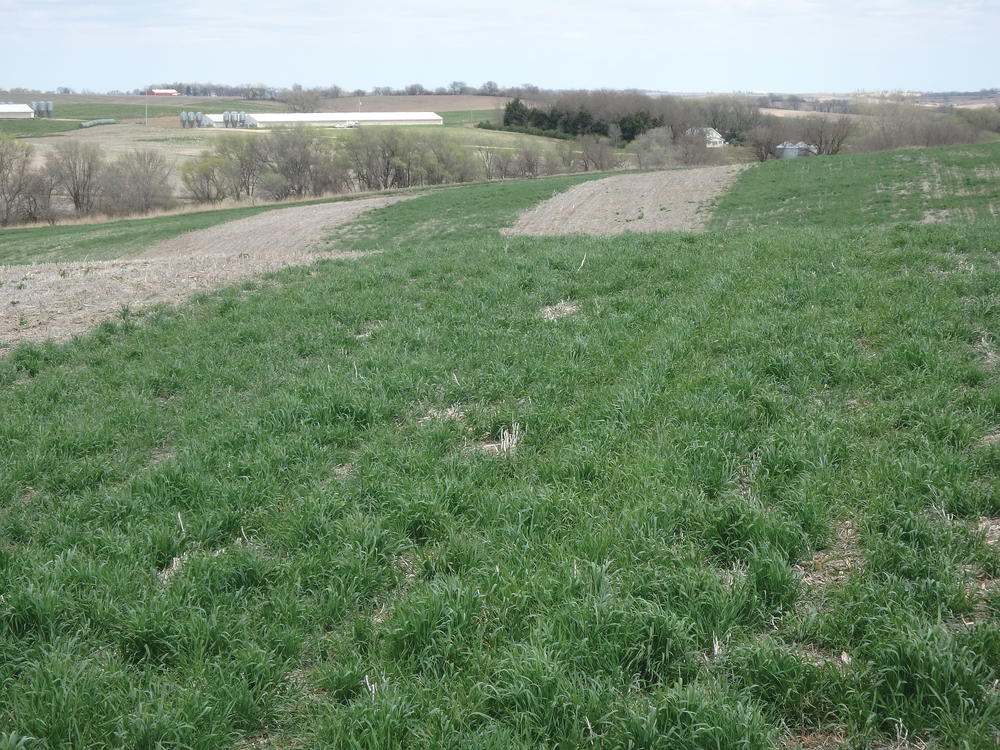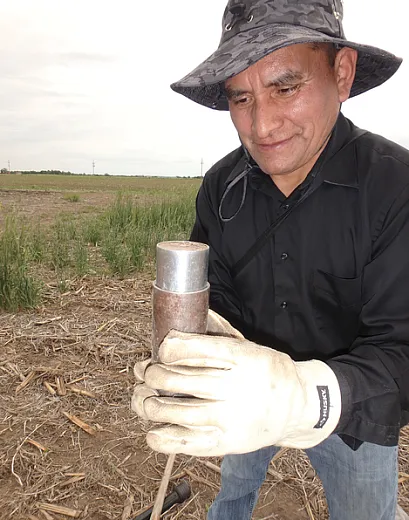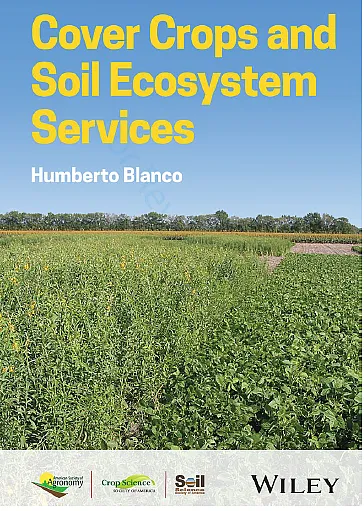Connecting Cover Crops With Ecosystem Services
Veteran Soil Scientist Humberto Blanco Uncovers Some Surprises on the Topic in His New Book

Over the course of his career, soil scientist Humberto Blanco has watched the number of publications on cover crops skyrocket year after year. A professor of soil management and applied soil physics at the University of Nebraska–Lincoln and an SSSA Fellow, Blanco eventually decided to take on the challenge of wrestling much of that information into a book. In Cover Crops and Soil Ecosystem Services (https://bit.ly/cover‐crops‐ecosystem‐services), just published by the Societies, he aims to clarify what scientists know—and don’t know—about those relationships. After reviewing some 500 articles, Blanco found that, in some instances, the science conflicts with common assumptions about cover crops. He also unearthed some intriguing nuggets about a practice that is not as recent as you might think.
This interview has been edited for length and clarity.
CSA News: You traveled back thousands of years when researching the history of cover crops for your new book. What surprised you most?
Blanco: Cover crops have been used for millennia. Indeed, cover crops were used by many, including Native Americans and George Washington. They probably did not call them “cover crops,” but they grew these plants between harvest and planting of the main crops. The practice of cover crops is not really new. Now, cover crops are a reemerging practice because of their many potential benefits.
CSA News: During most of the last 100 years, few scientific papers on cover crops were published. But around 1980, that number began to soar, and that trend continues.
Blanco: There’s been an exponential increase in publications on cover crops, and it’s very exciting. This book synthesizes such publications regarding the services that soils provide—what we call soil ecosystem services: carbon sequestration, weed management, soil health, water quality, and things like that. I organized the book in a way that answers the question, “Can cover crops improve the services that soils provide, and what are those services?”

CSA News: Up until the turn of the century, the main reasons for using cover crops were to control water and wind erosion, improve soil fertility, and suppress pests and disease. Then interest expanded to include the other benefits of cover crops. Why that shift in interest?
Blanco: In the old days, cover crops were mostly grown for improving soil fertility. There wasn’t a lot of inorganic fertilizer available, so farmers used cover crops like legumes to fix some nitrogen and improve soil productivity. But now, with concerns about environmental quality, soil degradation, water pollution, and things like that, many are looking at how cover crops address those issues. That’s one of the reasons I wrote this book. A lot of people think, “Oh, cover crops can do all of these things.” So I said, “What if we summarized this? What does research really say about cover crop benefits? And how can we generate income from cover crops?”
CSA News: Despite the increase in academic interest in cover crops, adoption rates remain quite low. Why is that?
Blanco: It depends on the county, the state, and country. In some regions, the adoption is maybe 10 to 15%. But in general, it seems to be only 5%, not more than 10%. The number one reason is definitely economics. If cover crops are not going to generate income, then interest is not there for everyone. We know there are farmers who really think about soil and water conservation or land stewardship, but cover crops can be expensive—seeds, planting, equipment, and labor. It’s a long‐term investment. It is about taking care of this soil for the present and future generations.
But some farmers, probably for valid reasons, expect immediate return in the first or second year. Also, some farmers do not own land—they’re renting. So they may be more interested in short‐term than long‐term benefits—next 5, 10, or 15 years.
Another reason is management because managing cover crops is different from managing main crops .
CSA News: You talk in your book about how putting a true monetary value on cover crops can be a challenge. Why?
Blanco: The book has a couple of chapters near the end about economics—ways by which cover crops can generate income, such as grazing for livestock, haying, or harvesting. Another way would be using legume cover crops to reduce fertilizer costs. In smaller‐scale farming, cover crops can replace inorganic fertilizers. In large‐scale farming, they can help reduce the total amount of inorganic fertilizer applied, which is another way of generating income.
Also, cover crops have potential to sequester C in the soil. Then, farmers can get some income from that through C credits. But how about putting a dollar value on reduced erosion and improved water quality, improved soil structural quality, biological activity, and things like that after cover crop adoption? At the moment, that’s not being quantified in terms of dollars.
CSA News: Are there a lot of misconceptions out there on the benefits of cover crops?
Blanco: Yes, definitely. Just one example is carbon sequestration. We hear in some agendas, even from the Biden administration, that we can plant cover crops and sequester carbon. That’s possible, but not in all soils. Some soils do not have enough room to sequester carbon; they are already close to carbon saturation. Some soils are hungry for carbon. But unfortunately, those may be in marginal lands with low precipitation and low fertility soils, which can limit enough cover crop biomass input. So, we cannot just say, “Let’s put cover crops everywhere, and then we will sequester a lot of carbon.” In some cases, yes, but not in all cases. The potential of cover crops to sequester carbon should be considered on a site‐specific basis.
For instance, farmers won’t see large benefits from cover crops if biomass production is low. So we need to identify management strategies to boost biomass production on a site‐specific basis. That depends a lot on cropping systems and other practices, including cover crop planting and termination dates.
CSA News: As you discuss in your book, cover crops have a positive impact on most soil ecosystem services, including weed management, biomass production, soil health, wind and water erosion, and soil fertility. But can you explain why nutrient management is more of a mixed bag?
Blanco: Yeah, cover crops may not reduce the concentration of dissolved nutrients in runoff, like phosphates. If they produce enough biomass, cover crops are highly effective for reducing sediment concentration in almost 90% of cases. There is no question about that. But what about in cool environments, like in Canada and the northern U.S. where cover crops killed by frost can release some soluble nutrients? When snow melts, it generates runoff that will carry soluble nutrients. In some cases, the concentration of dissolved nutrients can be higher in fields with cover crops than in fields without cover crops. There is one paper from Kansas [Carver et al., 2022] talking about how cover crops increase the loss of dissolved P. That’s a bit surprising. So again: cover crop benefits need to be looked at on a regional basis, based on climate, cover crop species, fertilizer management, etc.
CSA News: Another mixed bag you discuss is the effect of cover crops on yields.

Blanco: That’s one of the first things some farmers would look at: Do cover crops increase yield? It depends on what you plant. Legume cover crops could reduce use of inorganic fertilizer and then increase crop yields. But what about grass cover crops or non‐legumes, specifically grasses like cereal or winter rice? They can immobilize nutrients and don’t decompose quickly after termination. So most of the immobilized nutrients won’t be released for the following crop. Such cover crops could reduce yields.
Also, cover crops use water needed for the next crop. That’s a big concern in water‐limited regions. So we really need to consider that cover crops provide a lot of benefits, but an increase in crop yields may not be one of them in some cases.
One surprise could be that cover crops, for example, improve soil physical properties, like aggregate stability, water infiltration, and other soil properties. But those positive changes in soil physical properties do not seem to equate with increased yield. I’m not saying that improvement in soil physical properties is not needed and should be ignored: We need cover crops to improve soil properties for many valid reasons, but don’t think that improving physical, chemical, and biological properties automatically translates into increased yield.
CSA News: Given this complexity, how can farmers decide what to do?
Blanco: The first thing is we need to identify the goal for putting in cover crops. If the goal of the farmer is to increase yields, then we might need to think about legumes. But remember that legume cover crops might not match or produce more yields than highly fertilized systems. If the goal is to reduce erosion or sequester C, then we can pick cover crops that produce a lot of biomass quickly. So, it depends a lot on the goal. If we just put in a cover crop at random without much consideration of the goal, it’s not going to deliver all the services.
CSA News: What are the biggest holes in the research currently?
Blanco: We really need to look at cover crops a bit more comprehensively. There are thousands of papers, but some papers look at soil physical properties, and others look at chemical properties. But we need to look at all the ecosystem services for a given region more comprehensively.
Assessing all the benefits coming from cover crops takes time—five years or 10 years in some cases. We especially need more research data on soil biological properties. And, again, economics: We need to somehow put dollars on all soil ecosystem services. Cover crops still are not that popular—only 5–10% of cropland, which is worrisome. It should be at least 50%. So we need to show more benefits from cover crops.
CSA News: Any final thoughts about cover crops and ecosystem services?
Blanco: One word probably summarizes everything from this book: Management. We need to know how to manage cover crops. If cover crops are not providing benefits in a given region or soil, there has to be a way to make crops work in that system. Maybe we’re planting cover crops very late or killing them a bit too early. Management is key to be successful with cover crops and attain any benefits.
Purchase <i>Cover Crops and Soil Ecosystem Services</i>
You can purchase Cover Crops and Soil Ecosystem Services by visiting https://bit.ly/cover‐crops‐ecosystem‐services scanning the QR code here. Members can save 20% on the book by applying the promotional code 3SA20 before making payment. For more information, please contact books@sciencesocieties.org.
Reference
Carver, R.E., Nelson, N.O., Roozeboom, K.L., Kluitenberg, G.J., Tomlinson, P.J., Kang, Q., & Abel, D.S. (2022). Cover crop and phosphorus fertilizer management impacts on surface water quality from a no‐till corn–soybean rotation. Journal of Environmental Management, 301, 113818, https://doi.org/10.1016/j.jenvman.2021.113818
Text © . The authors. CC BY-NC-ND 4.0. Except where otherwise noted, images are subject to copyright. Any reuse without express permission from the copyright owner is prohibited.











